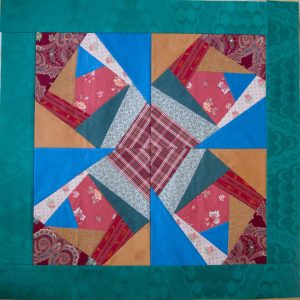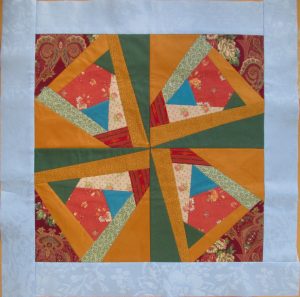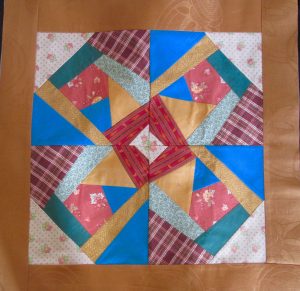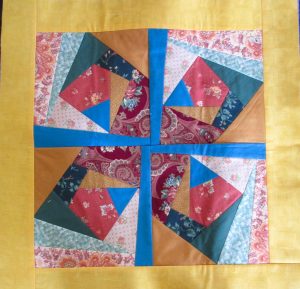It’s been a while since I was immersed in patchwork.
Twenty years ago, when I lived in Ségou, Mali, and I was teaching patchwork quilting to women’s sewing groups (at their request) as an economic development project, I spent all my free time at my old, hand-cranked, Chinese-made Butterfly sewing machine in the spare room of my house, sewing pieces of colorful African fabric together to make whatever I thought the women might emulate then ultimately sell to supplement their families’ incomes: pot holders, tote bags, wall quilts, baby quilts, bed coverings, even fabric checkerboards.
I loved it. I felt like a scientist in her own private laboratory. Which of these experiments will work? I wondered. Which items will be most successful at earning these talented and industrious Malian women extra money? I hadn’t been a quilter before Mali, so I had to learn from the ground up. But I enjoyed every moment that I climbed that particular learning curve.
After returning to the States in 2001, I had to pursue other avenues in order to deal with the realities of life as a single, self-supporting American woman: I earned an MFA, taught at the college level, did freelance book editing, and wrote three books. My sewing machine collected dust.
Now that I’m retired and living affordably in Mexico – and I’ve brought my beloved little Janome machine back from Taos – I’ve been happily sewing again. And I’ve resumed work on a patchwork project I started many years ago. (See last week’s post, “The Things Worth Keeping,” for an earlier photo.)

Every Monday afternoon here in San Miguel de Allende, when I have my private Spanish lesson with my ever-patient (saintly, really) maestra, Edith, she asks me (we strive to conduct our lessons entirely in Spanish in a never-ending effort to improve my conversational skills) what I’ve been up to during the past week. At our last meeting I tried to tell her about my patchwork project, which has been occupying a lot of my time lately. I groped for the right words to explain the concept.
“I’m sewing pieces of fabric (pedazos de tela) together (junto) to make a design (hacer un diseño) and then making blocks (cubos), or “bricks” (ladrillos) out of them to sew together.”
She didn’t get it. She looked at me quizzically.
I tried to show her with my hands. I tried to draw pictures.
She still didn’t get it.
“Por qué?” she asked, which I interpreted to mean, Whatever for?
“Para la cama (for the bed),” I said.
“Ah, una colcha!” she said, looking a little more enlightened. “Pero (but),” she added, por qué???” (This question seemed to me to imply: Why bother going to so much trouble when you can buy an inexpensive bedspread at the mercado?)
“Es un pasatiempo solamente (Is it only a pastime)?” she wanted to know.
Clearly, I thought, Edith is not familiar with patchwork quilting and how addictive it can be.
“No, es mi arte!” I responded defensively.
She continued to look puzzled. Her facial expression still asked, BUT WHY?
This conversation risked taking a decidedly existential turn. Why do any of us do anything? Why do bricklayers slap goopy globs of mortar between bricks and stack those bricks on top of each other to make new homes? Aren’t there enough homes in town already? Why do I write every morning of my life for no one but my notebook? Why are we here on Planet Earth anyway? Why is the sky blue?… And on and on.
When I was about three years old, as I recall, my favorite new word was WHY. I badgered my beleaguered mother with questions – why this and why that – following her around the house like the shadow-of-her that I was. She would throw up her hands, admit she didn’t have all of life’s answers, and beg me to save my good questions for my teacher when I got to kindergarten. “But that’s two years from now!” I whined. “I know you can do it, Bon,” she said, soothingly. She had great faith in me.
Even if I knew the Spanish words, I couldn’t have explained to Edith why making these crazy-quilt-design squares – these building blocks — out of pieces of fabric I’ve collected throughout my travels and life gives me such pleasure now. How does one adequately express the purpose of art? I certainly don’t have the words at the moment, in any language. Maybe in two years.
~ ~ ~
For the whole story of my Patchwork Project in Ségou, Mali, please read my memoir HOW TO MAKE AN AFRICAN QUILT (Nighthawk Press, 2013).



